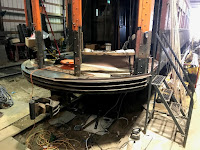Frank writes...
The weather on Sunday was unusually balmy, with a high of 60 degrees, so it was an ideal day to head out to IRM. When I arrived most of the car shop crew - including Joel, Greg, Good Nick, and Thomas, along with Wes from the diesel shop - were out on the line car inspecting the overhead and making repairs and adjustments where needed. I've been promised some photos documenting this.
After some drilling, dowls, and screws, the section of drip rail was reattached. We will likely want to replace much of this drip rail, as there are some short sections missing and it seems like running off some longer sections would be better than piecing in short lengths, but that's for later. This view is looking west/northwest along track 73; west of the 18 are the 972 and 205.
The car's trolley base was too heavy to hoist up to the roof myself, but the trolley hook wasn't. So after locating appropriate hardware I bolted it to the car's roof boards. This is looking east; next to the 18 on track 73 is our other Shaker Heights car, PCC 63, which is currently out of commission with MG problems, and beyond it the Matchbox. Over on 72 is a rake of 4000s while on track 74 you can see the 144 with the open car and 3142 beyond it.
Stepping back a couple of feet, you can see a couple of interesting items on the roof of the 18. It's obvious where the trolley base will go, and off to the right is the fuse box. That loop on the left would have held a spare trolley pole, which is something I tend to associate more with interurbans than with suburban lines. At the far end of the trolley boards is a hook - barely visible as a shadow in the preceding photo - which I assume is where you'd hang the harp of your spare pole. Another intriguing detail is that the roof canvas of this car is divided into three strips, a strip down each side of the roof and a strip down the middle that's just wider than the trolley boards. Car 18 had a row of Scullin ventilators down its entire roof until it was rebuilt around WWII. I wonder whether the roof canvas may have been patched in when those ventilators were removed, which would make this canvas at least 85-90 years old. It's pure speculation though.
I spent a few minutes hauling some excess wire pieces around in the golf car for the line car crew when they returned to the property, but that was about it for my useful contributions. I did have time (of course) to wander around aimlessly taking photos. Above we see a rebuilt motor for the L4, recently back from the motor shop.
There isn't a lot of progress being made currently on the S105 but I snapped a photo anyway since it's one of the most recent arrivals in Barn 4.
The recent progress on reassembly of the rear end of of Michigan Electric 28 is impressive. Virtually the entire wooden floor is installed, as are the baggage door thresholds.
As I mentioned earlier, Zach and Brian were working on the 757, addressing the few electrical gremlins with the car. Here Zach shows off a rebuilt board that has something to do with the battery-powered emergency lighting circuit (thanks for the correction Zach!); nearly out of sight underneath the car is Brian, getting ready to install the board. They were also working on the 757's smoker door and on fitting the new end windows for the car.
At the end of the day, it was suggested that the Toronto CLRV should be powered up to avoid any unnecessary sit-itis. Above can be seen the interesting setup for this. The usual trolley bus stinger, with forked hooks at the end for the positive and negative wires on the trolley bus line, can be seen hung on the wires to the left of the railroad crossing sign. The negative wire is clamped to the rail on the wide-gauge panel track while the positive is hooked to the car's trolley pole. And voila! Unfortunately, there was no voila this time, as the car's batteries had drained down and it didn't want to start up until they were recharged. But I was told that when the crew returned to the museum after dinner, and after some time on a battery charger, the car was powered up without any trouble.










No comments:
Post a Comment